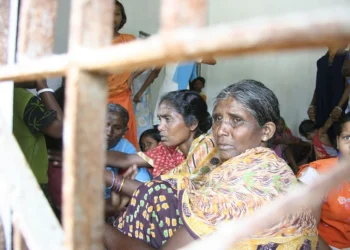Imogen Sadler is a public and election law barrister. She is a member of the Executive Committee of the Society of Conservative Lawyers.
The long-promised Labour Crime and Policing Bill was published on Wednesday, as part of a legislative programme by the Labour Government which has promised it will boost police resources, tackle anti-social behaviour and knife crime and prioritise the safety of women and girls. Whether this legislation will achieve its aim is a matter which will no doubt be debated over the coming weeks, but with public trust in the police low, this is an area in which all political parties need to focus their minds on and take the initiative.
How should this be done? Being tough on crime is all very well, but the prison system is clearly in crisis and we are simply running out of space. No one wants a situation where dangerous individuals are being released early and going on to re-offend, as happened last year.
The Labour Government has commissioned the former Lord Chanceller, David Gauke, to carry out a review into sentencing, with the interim review being published last week. It will consider a number of matters, including rehabilitation in prison, which is admirable and important in preventing re-offending.
However, another matter it is alternatives to custody. As I will set out in this article, it is crucial that any such approach does not simply cause criminals to think that they can get away with more. Some alternatives simply fail to have a deterrent effect, and any proposed alternatives must be carefully thought through to ensure they simply do not have the effect of failing to protect the public.
It is also vital, particularly in the case of sexual offences, that all political parties turn their minds to key flaws remain in the current legislative framework to ensure that these horrendous offences are stopped.
Protecting the public: after custody
When we think of protecting the public from offenders, it is sentences imposed which tend to come to mind. However, this is far from the whole picture.
Orders to continue to protect the public after a prison sentence are a matter I come across in my legal practice. There are a number of these, such as license conditions, but I will focus on those regarding sexual offences, which is where flaws currently lie.
These include notification requirements (colloquially known as being on the Sex Offenders Register), where offenders must provide details to the police of their address, details of passport, any plans to travel overseas and so on. In order for an offender to be subject to one of these, they must have carried out an offence listed in Schedule 3 of the Sexual Offences Act 2003 (SOA 2003).
I also frequently come across Sexual Harm Prevention Orders (‘SHPOs’) which allows a court to impose both negative prohibitions and positive obligations on individuals found guilty of offences set out in Schedule 3 and also Schedule 5 of SOA 2003.
These conditions need to be proportionate, and the Court needs to be convinced that the order will minimise the risk of harm to the public or to any particular members of the public.
For instance, should the underlying conviction have an online element, such as being on so-called paedophile chatrooms, courts may wish to add conditions allowing police to check the perpetrators’ devices, details of which should be given to the police.
Should it involve children, conditions may be added prohibiting any contact with an individual who is under 18. Any breach of such an order could trigger arrest and a return to court, and indeed jail time.
However, these are not watertight, and there are alarming instances of offenders falling through the gaps.
To take an example from my own practice which, despite many court appearances since, has stayed with me:
I once encountered a Defendant who had already been found guilty of creating a prohibited image under section 62(1) of the Coroners and Justice Act 2009 (possession of prohibited images of children). In this case, he had created AI child pornography and posted frequently on social media about his desire to have sexual relationships with very young underage girls. In police interview, he freely admitted being sexually attracted to children and expressed his concern that he was worried about his offending escalating. He even told me as much as I waited outside the court room for the case to go on.
The police force who had instructed me were asking me to seek a Sexual Risk Order (‘SRO’) against him. This are similar to SHPOs but tend to be more difficult to obtain as 1) you need to make an independent application to a Court for them (as opposed to SHPOs which you can apply to from the Court immediately after conviction, meaning that protection for members of the public, if they are granted, is immediate) and 2) do not rely on any underlying conviction so tend to be harder to get.
I remember turning through the pages on a fairly stomach-turning legal bundle (and given the cases I’ve done, I have a strong stomach). My first thought was why on earth had a SHPO not already been applied for? This individual had been walking around with no restrictions for months.
It turned out that under SOA 2003, Schedule 3 para 35B and 92, a SHPO for the creation of a prohibited image was only possible if the perpetrator had received a sentence of more than two years. This Defendant’s sentence had been for six months (and had been suspended) so he wasn’t eligible for a SHPO.
In this instance, I was successful in getting an SRO, but I worry that in another case it could have been different and this individual who was clearly a risk would have been left free to offend again without restriction.
The problem will be the same with many other sexual offences. For instance, the new creation offences for non-consensual pornographic deepfakes (or image based sexual abuse as some campaigners prefer and I go on to discuss in more detail below) the offences will not currently be on Schedule 3 and 5, so in instances like in my case, it will not be possible to apply automatically after sentence for a SHPO, even in extreme cases.
This is a loophole which needs urgently addressing and frustratingly is not mentioned in the Crime and Policing Bill, which focuses on Stalking Protection Orders only. Whilst the Bill expands the list of restrictions which those on the Sex Offenders Register can be subject to, it fails to deal with those who may, whilst committing deplorable offences, fall outside the strict list of offences which make one eligible for inclusion.
Criminalisation of non-consensual deepfake pornography
The Government’s approach to criminalising non-consensual deepfake pornography is another key example of where the Labour Party have so far taken completely the wrong approach regarding sexual offences and its proposed alternative to custody will not have the deterrent or protective effect required, causing much disappointment and distress to victims and campaigners.
The policy (which was in their manifesto) is right: it would criminalise cases where, using AI, victims (without their knowledge and consent) have had their faces imposed on sexually explicit images – it is almost a tech-enabled form of “revenge porn” that does not even need a nude photograph to exploit.
However, it took the tabling of a private members bill on the subject to kick them into action and promise to legislate and eventually agreed that an offence would be created immediately using amendments the Data (Use and Access) Bill [HL].
The first amendment was a copy and paste of a previous Bill which never passed through Parliament due to the election. When campaigners criticised the approach taken in this amendment, the Government bizarrely attempted to argue that key changes suggested by campaigners were not compliant with ECHR obligations (pretty unlikely stuff), before backing down and conceding it was compliant after all.
New amendments were then drafted, but these were again weak, most importantly saying that the maximum sentence that could be handed out was a fine – even in the most extreme cases. It is extraordinary that this was put forward at all.
To paraphrase Lord Pannick KC’s speech in the debate, this would tie the hands of judges and magistrates. What if the Defendant had committed the crime on an industrial scale with hundreds and thousands of victims? What if the Defendant had previously been in a relationship, and created the image to humiliate her? What if the victim was particularly vulnerable? What if he had been convicted of the offence multiple times. In such case a fine would surely be insufficient. Baroness Kennedy also pointed to the fact that in many cases fines simply do not work. They might not bother a rich Defendant nor a very poor Defendant who has no money and simply cannot pay the fine.
In case this didn’t already seem enough like an episode of the Thick of It, the Government again attempted to use the ECHR as an excuse for their approach. Senior lawyer after senior lawyer – Conservatives, Labour, Liberal Democrat and Crossbench Peers stood up in turn to pan the proposal.
The Government, however, pressed on regardless to a vote on their amendments. These were resoundingly defeated in the Lords, and a much stronger offence put in place.
It was hoped again that this might be dealt with in the Crime and Policing Bill, however yet again the proposed amendments to the law are limited and focus far more on voyeurism related offences as opposed to expanding and, to coin a phrase frequently used in the House of Lords debate, “future-proofing” the law in this area, given the fast-paced expansion and use of AI, and it seems that already the Bill leaves much to be desired.
I will not pretend there are easy answers. But any political party who wants to ‘prioritise the safety of women and girls’ (and it is against this group that the majority of sexual violence is perpetrated) needs to ensure that an approach is taken that discourages offenders from offending again and protects their victims.
Batting offences like this away with a fine, and no firmer consequences, is simply not good enough, and failing to protect individuals from serial sexual offenders continues to leave women and girls at serious risk.






![Trump's Admin Guts Another ‘Rogue Government Agency with Zero Accountability’ [WATCH]](https://www.right2024.com/wp-content/uploads/2025/03/Trumps-Admin-Guts-Another-‘Rogue-Government-Agency-with-Zero-Accountability-350x250.jpg)
![‘We All Owe Him (Elon) a Huge Debt of Gratitude’ [WATCH]](https://www.right2024.com/wp-content/uploads/2025/03/‘We-All-Owe-Him-Elon-a-Huge-Debt-of-Gratitude-350x250.jpg)



![NCAA Champ Salutes President Trump After ‘BIGGEST UPSET IN COLLEGE WRESTLING HISTORY’ [WATCH]](https://www.right2024.com/wp-content/uploads/2025/03/NCAA-Champ-Salutes-President-Trump-After-‘BIGGEST-UPSET-IN-COLLEGE-350x250.jpg)





